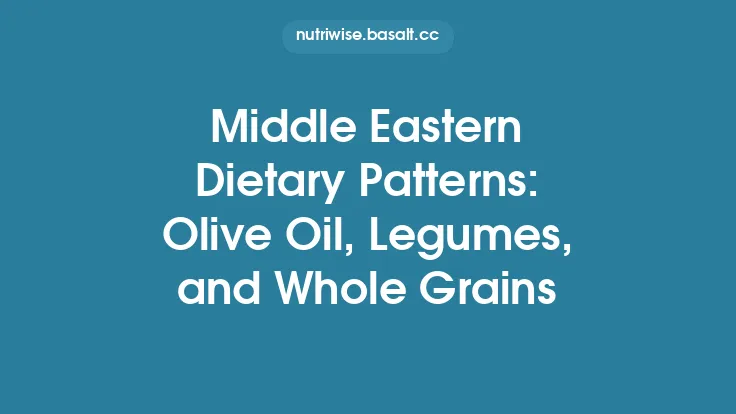Middle Eastern mezze—an array of small, flavorful dishes shared among friends and family—has long been more than a culinary curiosity. It is a social contract, a nutritional strategy, and a cultural blueprint that turns a simple gathering into a balanced, nutrient‑dense feast. By examining the historical roots, typical components, and the way mezze is assembled on the table, we can see how this tradition delivers a surprisingly complete nutritional profile while reinforcing community bonds.
Historical Foundations and Social Function
The practice of serving many bite‑size dishes dates back to the Ottoman courts of the 15th century, where “meze” (from the Persian *mazze* meaning “taste” or “relish”) was a pre‑meal indulgence for the elite. Over time, the concept migrated across the Levant, the Arabian Peninsula, and North Africa, adapting to local ingredients and customs. In most societies, mezze is offered:
- Before the main course – to stimulate the palate and signal hospitality.
- During social gatherings – as a conversational catalyst, encouraging guests to linger and interact.
- As a stand‑alone meal – especially during Ramadan evenings (iftar) or on leisurely weekends.
Because the dishes are served communally, the act of sharing reinforces social cohesion, a principle that underpins many Middle Eastern cultures where generosity (karam) and collective well‑being are prized.
Core Structural Elements of a Mezze Spread
A traditional mezze layout follows a loosely defined hierarchy that balances flavors, textures, and nutritional categories:
| Category | Typical Examples | Nutritional Contribution |
|---|---|---|
| Fresh Vegetables & Salads | Tabouleh, fattoush, cucumber‑yogurt (tzatziki), pickled turnips | High in fiber, vitamins A, C, K, folate; low energy density |
| Legume‑Based Dips | Hummus, ful medames, muhammara (walnut‑pepper dip) | Plant protein, complex carbs, soluble fiber, minerals (iron, magnesium) |
| Fermented & Preserved Items | Labneh, olives, pickled vegetables | Probiotics, healthy monounsaturated fats, antioxidants |
| Grains & Starches | Warm pita, flatbreads, bulgur, rice‑based salads | Energy‑dense carbs, B‑vitamins, additional fiber |
| Nuts & Seeds | Roasted almonds, pistachios, sesame‑seed tahini | Healthy fats (MUFA, PUFA), vitamin E, trace minerals |
| Protein‑Rich Small Plates | Grilled halloumi, kebbeh, kofta, fried falafel | Complete or complementary proteins, iron, zinc |
| Condiments & Spreads | Harissa, sumac, za’atar, pomegranate molasses | Phytochemicals, micronutrients, flavor enhancers that reduce the need for added salt or sugar |
The arrangement is intentionally modular: each component can be combined with others (e.g., hummus on pita, olives with cheese) to create a spectrum of macro‑ and micronutrient pairings. This modularity is a key reason why mezze can meet daily nutritional recommendations without a single “main” dish.
Macronutrient Balance Through Small Plates
When a typical mezze spread is consumed in moderate quantities, the macronutrient distribution often approximates the following ratios:
- Carbohydrates: 45–55 % of total calories
*Derived mainly from whole‑grain breads, bulgur, and starchy vegetables.*
- Proteins: 15–20 % of total calories
*Supplied by legumes, dairy (labneh, halloumi), nuts, and occasional meat or fish.*
- Fats: 30–40 % of total calories
*Predominantly unsaturated fats from olive oil, nuts, and tahini.*
These ratios align closely with many dietary guidelines for chronic disease prevention. The presence of fiber (from legumes, vegetables, and whole grains) slows glucose absorption, moderating post‑prandial blood sugar spikes. Meanwhile, the healthy fat profile—rich in oleic acid from olives and monounsaturated fats from nuts—supports cardiovascular health.
Micronutrient Density and Phytochemical Richness
Mezze’s diversity translates into a broad micronutrient spectrum:
- Vitamin C: abundant in fresh herbs (parsley, mint), lemon juice, and raw vegetables.
- Vitamin K & Folate: high in leafy greens and parsley‑heavy tabouleh.
- Iron & Zinc: supplied by legumes, meat kebabs, and fortified breads.
- Calcium & Vitamin D: present in dairy items like labneh and halloumi; occasional inclusion of fish (e.g., sardines) boosts vitamin D.
- Antioxidants: sumac, pomegranate molasses, and roasted red peppers deliver polyphenols that combat oxidative stress.
Because the dishes are consumed together, the bioavailability of certain minerals improves. For instance, the vitamin C in lemon‑squeezed salads enhances iron absorption from plant sources, while the fat in tahini aids the uptake of fat‑soluble vitamins (A, D, E, K) from other components.
Portion Control and Satiety Mechanics
The small‑plate format naturally encourages mindful eating:
- Visual Variety: A colorful spread signals abundance, reducing the urge to overeat a single item.
- Sequential Sampling: Guests typically take a bite, pause, and then move to another dish, allowing satiety signals to register.
- Fiber‑Rich Base: High‑fiber items (bulgur, salads) increase gastric distension, promoting fullness with fewer calories.
Research on “plate‑size effect” shows that when food is presented in multiple small containers, overall intake can be reduced by 10–15 % compared with a single large plate. Mezze leverages this principle without compromising cultural expectations of generosity.
Regional Variations and Their Nutritional Implications
While the core concept remains consistent, regional twists introduce unique nutrients:
| Region | Signature Additions | Nutritional Highlights |
|---|---|---|
| Levant (Syria, Lebanon, Jordan) | Kibbeh (bulgur‑meat shells), muhammara (walnut‑pepper dip) | Higher omega‑3 from walnuts; added protein from meat. |
| Gulf (Saudi Arabia, UAE) | Sambousek (fried pastry), machboos‑style rice bites | Increased caloric density; higher saturated fat if deep‑fried. |
| North Africa (Morocco, Tunisia) | Brik (thin pastry with egg), harissa‑spiced olives | Boost in vitamin A from egg yolk; capsaicin from harissa may raise metabolic rate. |
| Turkey | Ezme (spicy tomato‑onion salad), çiğ köfte (raw bulgur meatball) | Rich in lycopene; raw bulgur retains more B‑vitamins. |
Understanding these variations helps nutritionists tailor recommendations for specific populations while preserving cultural authenticity.
Health Benefits Documented in Contemporary Studies
A growing body of epidemiological research links regular consumption of mezze‑style meals with favorable health outcomes:
- Cardiovascular Protection: The Mediterranean‑style emphasis on olive oil, nuts, and legumes correlates with lower LDL cholesterol and reduced incidence of coronary artery disease.
- Metabolic Regulation: High fiber and low glycemic index components improve insulin sensitivity, lowering the risk of type 2 diabetes.
- Gut Microbiome Diversity: Fermented items (labneh, pickles) and prebiotic fibers (chickpeas, onions) foster a diverse microbial community, which is associated with better immune function and mental health.
- Weight Management: The satiety‑inducing combination of protein, fiber, and healthy fats supports weight maintenance when portion sizes are moderate.
These findings reinforce the notion that mezze is not merely a culinary tradition but a functional eating pattern aligned with modern nutrition science.
Modern Adaptations Without Losing Core Principles
Urbanization and global food trends have prompted creative reinterpretations of mezze, yet the underlying structure remains intact:
- Plant‑Based Mezze: Replacing meat kebabs with grilled tempeh or roasted cauliflower provides comparable protein while reducing saturated fat.
- Gluten‑Free Options: Substituting traditional pita with chickpea flatbreads or cauliflower “pita” accommodates celiac patients without sacrificing the communal dip‑and‑bread experience.
- Low‑Sodium Strategies: Using lemon zest, sumac, and fresh herbs to flavor olives and pickles reduces reliance on added salt.
- Portion‑Sized Servings: Pre‑portioned mini‑plates or “mezze boxes” for take‑away maintain the variety while controlling caloric intake.
These innovations illustrate the flexibility of mezze: it can evolve to meet dietary restrictions and lifestyle changes while preserving its cultural essence.
Practical Guidelines for Building a Balanced Mezze Spread
For home cooks, nutritionists, or hospitality professionals seeking to design a nutritionally sound mezze, the following checklist can serve as a blueprint:
- Start with Fresh Greens: Include at least two raw vegetable salads (e.g., tabouleh, cucumber‑yogurt) for fiber and micronutrients.
- Add a Legume Base: Provide one or two dips (hummus, ful) to supply plant protein and complex carbs.
- Incorporate Healthy Fats: Offer olives, nuts, and tahini‑based spreads; drizzle olive oil sparingly over salads.
- Select Whole‑Grain Carbohydrates: Serve whole‑grain pita or barley crackers rather than refined breads.
- Include a Protein Highlight: Choose a modest portion of grilled fish, halloumi, or falafel to round out the amino acid profile.
- Balance Flavors: Use herbs, spices, and acidic elements (lemon, sumac) to enhance taste without excess salt or sugar.
- Mind Portion Sizes: Aim for 2–3 bites per dish per person; encourage guests to sample rather than fill plates.
- Finish with a Light Sweet: A small serving of fresh fruit or a drizzle of pomegranate molasses adds antioxidants and satisfies a sweet craving.
Following this framework ensures that the mezze not only delights the palate but also meets daily nutritional recommendations for macronutrients, fiber, and essential micronutrients.
Conclusion
Middle Eastern mezze exemplifies how a cultural tradition can simultaneously fulfill social, culinary, and health objectives. By presenting a mosaic of small plates—each contributing distinct nutrients, flavors, and textures—the mezze system creates a naturally balanced meal that aligns with contemporary dietary guidelines. Its emphasis on shared consumption, mindful portioning, and the strategic pairing of foods makes it a timeless model for nutritious eating. Whether enjoyed in a bustling souk, a family home, or a modern urban kitchen, mezze continues to prove that small plates can indeed deliver big nutrition.





